Items filtered by date: July 2024
Everything You Need to Know About Corns
Corns are hard and thick areas of skin that form as a result of constant rubbing, friction, or pressure on the skin. They are patches of dead skin with a small plug toward the center. They may appear on the tops and sides of toes and can make walking painful.
Soft corns are typically thinner with a white color and rubbery texture. Soft corns tend to appear between the toes. Seed corns are another type of corn that appear in clusters and can be tender if they are on a weight-bearing part of the foot. Seed corns usually appear on the bottom of the foot and are likely caused by a blockage in sweat ducts.
While corns and calluses are somewhat similar, calluses are a bit different. Calluses are a patch of dead skin that can occur anywhere on the body. In comparison to corns, calluses are usually a bit larger in size. However, both corns and calluses are caused by increased friction on the skin.
There are some risk factors that may increase your chances of developing corns and calluses. If you have bunions, hammertoe, or a bone spur, you are more likely to develop a corn or callus on your foot.
While Corns and Calluses tend to disappear when the friction to the affected area ceases, the help of a podiatrist may be useful in the removal process. It is important to remove the dead skin around the area and this may be done in a few different ways. Moisturizing creams may be helpful in softening and removing the dead skin around the callus. You should never use razors or other pedicure equipment to remove your corns. Doing this may worsen your corn or callus and cause infection.
In some cases, corns and calluses may be caused by abnormal foot structure or walking motion. In such a case, you should seek a podiatrist’s assistance in order to correct the issue.
Severe Corns and Calluses on the Feet
 Severe calluses are thickened areas of skin that develop on the feet due to repeated pressure or friction. They often occur on the heels, soles, and sides of the feet. Corns are similar to calluses but are smaller, with a hard center surrounded by inflamed skin, typically forming on the toes. These conditions can happen as a result of wearing tight or ill-fitting shoes, high-heeled shoes, or abnormal gait patterns. Calluses look like rough, thick patches of skin, while corns appear as hard, round bumps. They can cause discomfort, pain, and tenderness, making walking difficult. Relief can consist of soaking the feet in warm water, using pumice stones or foot files to remove thickened skin, moisturizing, and wearing properly fitted shoes. Complications can arise if calluses and corns are left untreated, leading to skin ulcers or infections, especially in individuals with diabetes. If you suffer from these ailments, it is suggested that you schedule an appointment with a podiatrist who can effectively treat uncomfortable corns and calluses.
Severe calluses are thickened areas of skin that develop on the feet due to repeated pressure or friction. They often occur on the heels, soles, and sides of the feet. Corns are similar to calluses but are smaller, with a hard center surrounded by inflamed skin, typically forming on the toes. These conditions can happen as a result of wearing tight or ill-fitting shoes, high-heeled shoes, or abnormal gait patterns. Calluses look like rough, thick patches of skin, while corns appear as hard, round bumps. They can cause discomfort, pain, and tenderness, making walking difficult. Relief can consist of soaking the feet in warm water, using pumice stones or foot files to remove thickened skin, moisturizing, and wearing properly fitted shoes. Complications can arise if calluses and corns are left untreated, leading to skin ulcers or infections, especially in individuals with diabetes. If you suffer from these ailments, it is suggested that you schedule an appointment with a podiatrist who can effectively treat uncomfortable corns and calluses.
If you have any concerns regarding your feet and ankles, contact Shaun J. Limon, DPM and Lisa Griffith-Limon, DPM of Limons Foot & Ankle Care. Our doctors will treat your foot and ankle needs.
Corns: What Are They? and How Do You Get Rid of Them?
Corns can be described as areas of the skin that have thickened to the point of becoming painful or irritating. They are often layers and layers of the skin that have become dry and rough, and are normally smaller than calluses.
Ways to Prevent Corns
There are many ways to get rid of painful corns such as wearing:
- Well-fitting socks
- Comfortable shoes that are not tight around your foot
- Shoes that offer support
Treating Corns
Treatment of corns involves removing the dead skin that has built up in the specific area of the foot. Consult with Our doctors to determine the best treatment option for your case of corns.
If you have any questions please feel free to contact our office located in Lakewood Ranch, FL . We offer the newest diagnostic and treatment technologies for all your foot and ankle needs.
